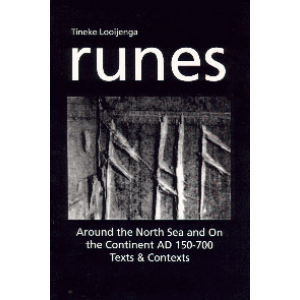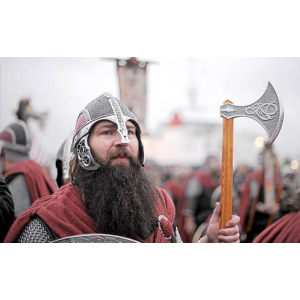
Book: Runes Around The North Sea And On The Continent by Jantina Helena Looijenga
Het onderzoek naar de oudste runeninscripties van het Europese Continent, Engeland en Denemarken voerde onderzoekster van Liverpool aan de Ierse Zee naar Constanza aan de Zwarte Zee; van Zurich naar Bergen; van Parijs naar Stockholm. In dit enorme gebied kende men reeds bij het begin van de vroege middeleeuwen het runenschrift (rond 500 AD). Ergens in dit gebied moet een kern gelegen hebben, waar het begon - vermoedelijk in de eerste eeuw AD. Het localiseren van dat oorsprongsgebied begon me in de loop van het onderzoek te intrigeren.Het doel was in eerste instantie het inventariseren, het beschrijven en analyseren van runenteksten uit de oudste periode: 150-700 AD. Als onderzoekscorpus waren de runentradities rondom de Noordzee en van het continent uitgekozen. Het uitgangspunt was nadrukkelijk niet Scandinavie, zoals bij runenstudies meestal het geval. Ik meende, dat een verandering van perspectief nieuw licht op oude runologische vraagstukken zou kunnen werpen - en daardoor wellicht bijdragen tot oplossingen. Bovendien wilde ik me niet op een land of traditie vastleggen, maar door middel van het vergelijken van Diverse runentradities proberen meer inzicht te krijgen in doel en wezen van het runenschrift. Waarom ontwikkelde men dit schrift, met welk doel werd het gebruikt, en door wie? Om dit soort vragen te beantwoorden, was het nodig om inzicht te verkrijgen in de cultuur-historische context van de inscriptiedragers. Archeologie en historie bleken onmisbare informatiebronnen; ook de (plaats)naamkunde leverde belangrijke gegevens ten aanzien van het relatief enorme aantal namen in de runencorpora.
Runologie heeft in principe twee poten: paleografie en historische taalkunde. Eerst inspecteert men persoonlijk de objecten en hun inscripties en vervolgens ontcijfert men de runen. Daarna verkrijgt men een of meer lezingen, weergegeven als transliteraties, die dan taalkundig worden geanalyseerd. Deze teksten kunnen niet zonder hun archeologische en historische contexten begrepen worden, vandaar de titel ‘Runes Around the North Sea and on the Continent AD 150-700;
Books in PDF format to read:
Hilda Roderick Ellis - Road To Hel A Study Of The Conception Of The DeadWim Van Den Dungen - Enoch And The Day Of The End
Jantina Helena Looijenga - Runes Around The North Sea And On The Continent

